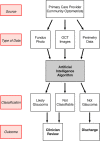Artificial Intelligence Algorithms to Diagnose Glaucoma and Detect Glaucoma Progression: Translation to Clinical Practice
- PMID: 33117612
- PMCID: PMC7571273
- DOI: 10.1167/tvst.9.2.55
Artificial Intelligence Algorithms to Diagnose Glaucoma and Detect Glaucoma Progression: Translation to Clinical Practice
Erratum in
-
Erratum in: Artificial Intelligence Algorithms to Diagnose Glaucoma and Detect Glaucoma Progression: Translation to Clinical Practice.Transl Vis Sci Technol. 2020 Nov 30;9(12):34. doi: 10.1167/tvst.9.12.34. eCollection 2020 Nov. Transl Vis Sci Technol. 2020. PMID: 33282542 Free PMC article.
Abstract
Purpose: This concise review aims to explore the potential for the clinical implementation of artificial intelligence (AI) strategies for detecting glaucoma and monitoring glaucoma progression.
Methods: Nonsystematic literature review using the search combinations "Artificial Intelligence," "Deep Learning," "Machine Learning," "Neural Networks," "Bayesian Networks," "Glaucoma Diagnosis," and "Glaucoma Progression." Information on sensitivity and specificity regarding glaucoma diagnosis and progression analysis as well as methodological details were extracted.
Results: Numerous AI strategies provide promising levels of specificity and sensitivity for structural (e.g. optical coherence tomography [OCT] imaging, fundus photography) and functional (visual field [VF] testing) test modalities used for the detection of glaucoma. Area under receiver operating curve (AROC) values of > 0.90 were achieved with every modality. Combining structural and functional inputs has been shown to even more improve the diagnostic ability. Regarding glaucoma progression, AI strategies can detect progression earlier than conventional methods or potentially from one single VF test.
Conclusions: AI algorithms applied to fundus photographs for screening purposes may provide good results using a simple and widely accessible test. However, for patients who are likely to have glaucoma more sophisticated methods should be used including data from OCT and perimetry. Outputs may serve as an adjunct to assist clinical decision making, whereas also enhancing the efficiency, productivity, and quality of the delivery of glaucoma care. Patients with diagnosed glaucoma may benefit from future algorithms to evaluate their risk of progression. Challenges are yet to be overcome, including the external validity of AI strategies, a move from a "black box" toward "explainable AI," and likely regulatory hurdles. However, it is clear that AI can enhance the role of specialist clinicians and will inevitably shape the future of the delivery of glaucoma care to the next generation.
Translational relevance: The promising levels of diagnostic accuracy reported by AI strategies across the modalities used in clinical practice for glaucoma detection can pave the way for the development of reliable models appropriate for their translation into clinical practice. Future incorporation of AI into healthcare models may help address the current limitations of access and timely management of patients with glaucoma across the world.
Keywords: artificial intelligence; glaucoma; machine learning.
Copyright 2020 The Authors.
Conflict of interest statement
Disclosure: A.S. Mursch-Edlmayr, None; W.S. Ng, None; A. Diniz-Filho, None; D.C. Sousa, None; L. Arnold, None; M.B. Schlenker, None; K. Duenas-Angeles, None; P.A. Keane: Heidelberg Engineering (F), Topcon (F), Carl Zeiss Meditec (F), Haag-Streit (F), Allergan (F), Novartis (F, S), Bayer (F, S), DeepMind (C), Optos (C); J. Crowston, Allergan (C); H. Jayaram, Allergan (C)
Figures
Similar articles
-
[Artificial intelligence and glaucoma: A literature review].J Fr Ophtalmol. 2022 Feb;45(2):216-232. doi: 10.1016/j.jfo.2021.11.002. Epub 2022 Jan 3. J Fr Ophtalmol. 2022. PMID: 34991909 Review. French.
-
Artificial intelligence and complex statistical modeling in glaucoma diagnosis and management.Curr Opin Ophthalmol. 2021 Mar 1;32(2):105-117. doi: 10.1097/ICU.0000000000000741. Curr Opin Ophthalmol. 2021. PMID: 33395111 Review.
-
Novel Approaches for the Early Detection of Glaucoma Using Artificial Intelligence.Life (Basel). 2024 Oct 28;14(11):1386. doi: 10.3390/life14111386. Life (Basel). 2024. PMID: 39598184 Free PMC article. Review.
-
Advancing glaucoma detection with convolutional neural networks: a paradigm shift in ophthalmology.Rom J Ophthalmol. 2023 Jul-Sep;67(3):222-237. doi: 10.22336/rjo.2023.39. Rom J Ophthalmol. 2023. PMID: 37876506 Free PMC article. Review.
-
Applications of deep learning in detection of glaucoma: A systematic review.Eur J Ophthalmol. 2021 Jul;31(4):1618-1642. doi: 10.1177/1120672120977346. Epub 2020 Dec 4. Eur J Ophthalmol. 2021. PMID: 33274641
Cited by
-
Using Artificial Intelligence to Analyse the Retinal Vascular Network: The Future of Cardiovascular Risk Assessment Based on Oculomics? A Narrative Review.Ophthalmol Ther. 2023 Apr;12(2):657-674. doi: 10.1007/s40123-022-00641-5. Epub 2022 Dec 23. Ophthalmol Ther. 2023. PMID: 36562928 Free PMC article. Review.
-
Current and Future Implications of Using Artificial Intelligence in Glaucoma Care.J Curr Ophthalmol. 2022 Jul 26;34(2):129-132. doi: 10.4103/joco.joco_39_22. eCollection 2022 Apr-Jun. J Curr Ophthalmol. 2022. PMID: 36147268 Free PMC article. No abstract available.
-
Artificial Intelligence and Glaucoma: Going Back to Basics.Clin Ophthalmol. 2023 May 31;17:1525-1530. doi: 10.2147/OPTH.S410905. eCollection 2023. Clin Ophthalmol. 2023. PMID: 37284059 Free PMC article. Review.
-
Artifact-Tolerant Clustering-Guided Contrastive Embedding Learning for Ophthalmic Images in Glaucoma.IEEE J Biomed Health Inform. 2023 Sep;27(9):4329-4340. doi: 10.1109/JBHI.2023.3288830. Epub 2023 Sep 6. IEEE J Biomed Health Inform. 2023. PMID: 37347633 Free PMC article.
-
Characteristics of a Large, Labeled Data Set for the Training of Artificial Intelligence for Glaucoma Screening with Fundus Photographs.Ophthalmol Sci. 2023 Mar 17;3(3):100300. doi: 10.1016/j.xops.2023.100300. eCollection 2023 Sep. Ophthalmol Sci. 2023. PMID: 37113471 Free PMC article.
References
-
- Mariotti SP. Global Data on Visual Impairment 2010. Geneva, Austria: World Health Organisation; 2010.
-
- Pascolini D, Mariotti SP.. Global estimates of visual impairment: 2010. Br J Ophthalmol. 2012; 96: 614–618. - PubMed
-
- Quigley HA, Vitale S.. Models of open-angle glaucoma prevalence and incidence in the United States. Invest Ophthalmol Vis Sci. 1997; 38: 83–91. - PubMed
-
- de Voogd S, Ikram MK, Wolfs RC, Jansonius NM, Hofman A, de Jong PT. Incidence of open-angle glaucoma in a general elderly population: the Rotterdam Study. Ophthalmology. 2005; 112: 1487–1493. - PubMed
Publication types
MeSH terms
Grants and funding
LinkOut - more resources
Full Text Sources
Medical


